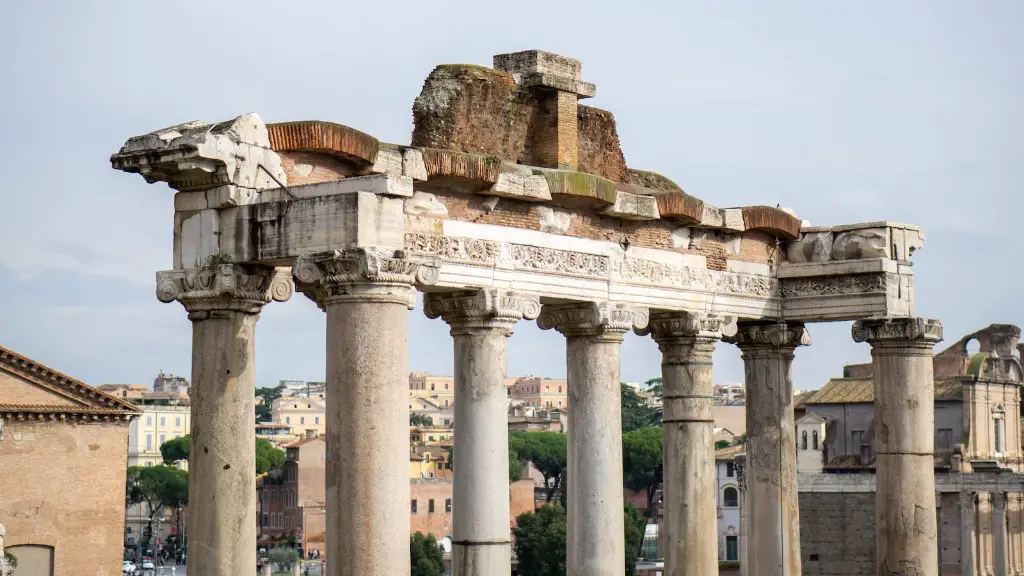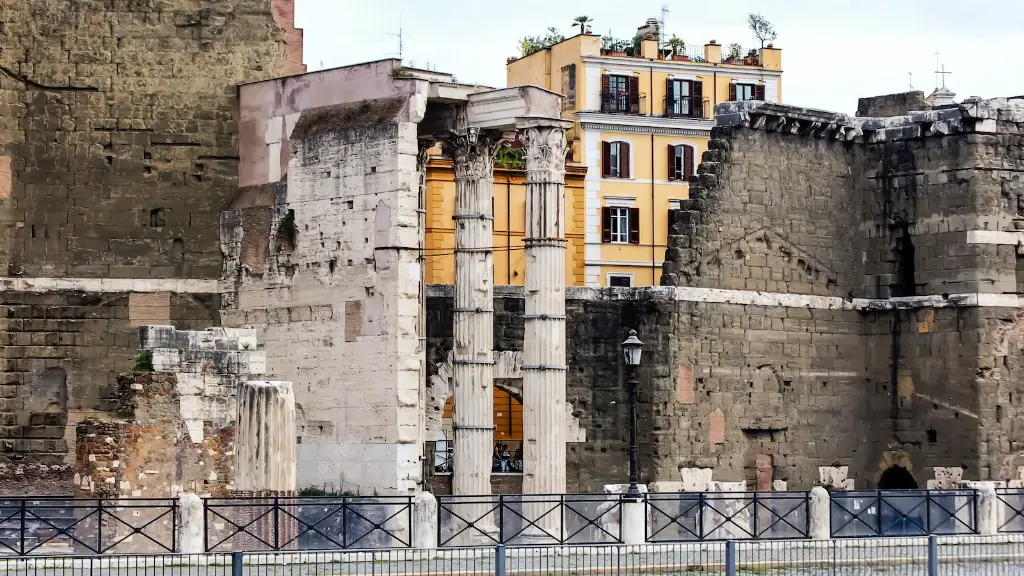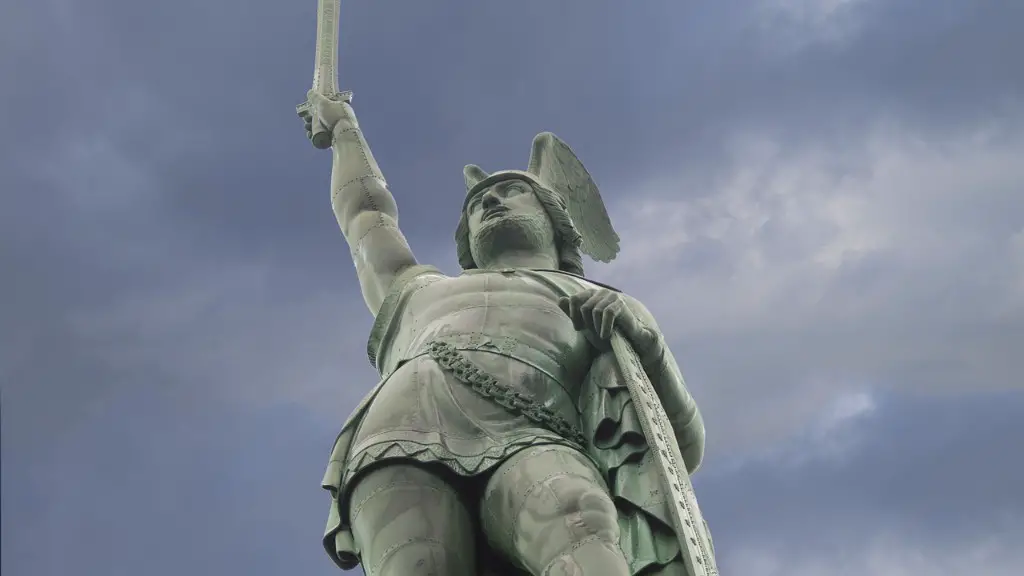The Colosseum in ancient Rome was an architectural marvel. Built by the Emperor Vespasian in 70-72 CE, the Colosseum was an oval-shaped building that overlooked the city of Rome. The building was originally known as the Flavian Amphitheatre, but because of its immense size it became known as the Colosseum. At just under 50 meters high and 185 meters long, it was the largest amphitheater in the Roman world, and was able to house up to 50,000 spectators. Inside the Colosseum there was seating divided by class: the Emperor had the best view in the center, while the common folk sat in the highest section of the stadium.
The Colosseum hosted a variety of different events. Gladiatorial combats, mock sea battles and wild animal fights were all popular entertainments that fascinated the citizens of Rome. Thousands of individuals were killed in these regular spectacles, with an estimated half a million people and one million animals having perished in the arena. Yet despite the carnage, these events were extremely popular among the Roman populace; the only days the Colosseum was closed were for religious festivals.
It was also used for political propaganda, with the Emperor often on hand to preside over the events. The Colosseum was a powerful tool for unifying the people of Rome and thereby demonstrating the strength of the Emperor’s rule. The architecture of the Colosseum was also very impressive in itself. It was built entirely from stone and brick, with marble and bronze statues of animals and Gods decorating the interior. In its time the Colosseum was the most technologically advanced building in Rome and it served as a template for many other structures in the ancient world.
It was not only technology that made the Colosseum such a marvel however, as its incredible size and grandeur were sure to wow any visitor that passed through its gates. The Colosseum stood proud over the skyline of the city, and would have taken the breath away of anyone who entered. It is no wonder it became the symbol of ancient Rome, and stands as a proud testament to the grandeur of the Roman Empire.
The Fall Of An Icon
The Colosseum remained standing for over 600 years, but eventually it began to decline as less and less sports were staged and the Roman Empire began to crumble. Earthquakes, weather, and other natural disasters all contributed to a decline of the building until it was in ruin by the 19th century. Many of the stones taken from the structure were used by locals to build houses and other structures, while bronze statues and other aspects of the Colosseum were melted down and used for other purposes.
The Colosseum’s decline was also in part due to its transformation from a stadium to a temple for Christianity. Although it did not last, it was during this time that the Colosseum began to be seen as a symbol of martyrdom rather than bloodshed and violence. In the 18th century scholars and architects began to realize the significance of the Colosseum and efforts began to protect it. This eventually led to the Colosseum being declared an Italian national monument in 2007, thus protecting it from further destruction and decay.
Preserving an Ancient Wonder
Today the Colosseum is one of the most recognizable monuments in the world. Millions of tourists come to marvel at its immense size and grandeur, and it is a popular destination for students of history who want to learn more about this iconic structure. While the Colosseum continues to be damaged by weather and other natural elements, major restoration projects are being implemented to preserve the monument for future generations. Comprehensive plans are in place to ensure that the Colosseum will continue to be a place of interest and beauty for centuries to come.
Modern Symbol of Ancient Rome
The Colosseum is a symbol of the grandeur and power of the ancient Roman Empire. Its vast size and impressive architecture was built to awe and inspire, and it still does today. It is a marvel of engineering, art and architecture, and a powerful reminder of the impressive civilization that once ruled much of the known world. No visitor to Rome should miss the chance to visit the Colosseum, and make sure to take the time to appreciate this amazing reminder of the past.
The Architecture Of The Colosseum
The Colosseum is an example of the Roman Empire’s engineering prowess. It is estimated that the building was made of more than 300,000 cubic metres of travertine stone and brick, and more than two million cubic metres of tufa – volcanic rock – used in its construction. The Colosseum is also made up of four distinct levels with 80 arches along the outside of each level. Each of these arches was designed to support the weight of the building, with the inner wall being made of stone and the outer wall being made of brick. The Colosseum is estimated to have taken 10 years to build, with six million people involved in its construction.
Impact And Influence On The World
The Colosseum has had a great impact and influence on the world. It stands as a symbol of the Roman Empire’s engineering and architectural prowess, and its impact can be seen in many modern-day stadiums around the world. The Colosseum has also been featured in countless films, television shows, videogames and other media, helping to keep its legacy alive for generations to come.
Fascinating Facts About The Colosseum
To this day, the Colosseum continues to fascinate the world with its size and beauty. Here are some interesting facts about the Colosseum that you may not have known:
- A combination of three types of material were used in the Colosseum’s construction – travertine stone, tufa and brick.
- The Colosseum is estimated to be capable of seating up to 50,000 spectators.
- In 391 CE Animals in the Colosseum were no longer allowed to be killed in combat, due to the rise of Christianity.
- The Colosseum was used for gladiatorial contests for over 500 years.
- The height of the Colosseum is estimated to have been over 50 meters.
- The Colosseum is the largest amphitheater in the world, with a length of 185 meters.
- The Colosseum has featured in many films and television shows, including Gladiator and Game of Thrones.
Maintenance And Preservation
The Colosseum is a fragile structure that must be meticulously maintained in order to preserve it for future generations. To this end, there are regular maintenance projects that are undertaken to ensure that the building does not decay further. In addition, restoration projects have been implemented to repair any damage that has been caused by weathering or other natural elements. The Colosseum is also constantly monitored to ensure its integrity is maintained, with the latest technology being used to keep track of the condition of the structure.



